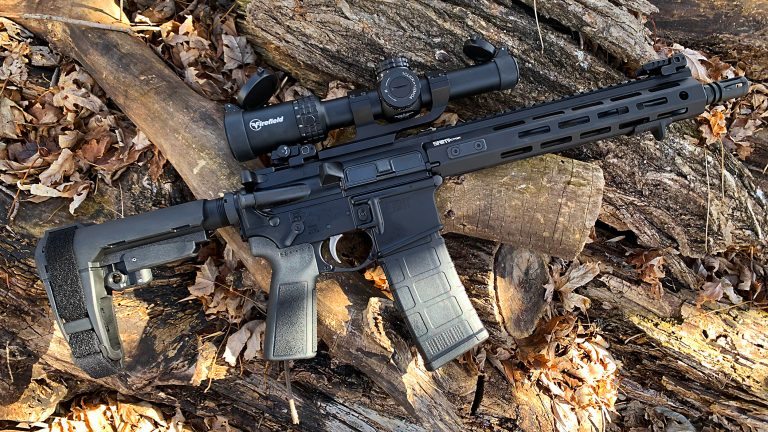I’ve been called a bit of a gear snob in my day, whether talking about top ten firearms lists or how I choose to set up my guns, especially speaking of optics.
But I’ve been on this earth for a while, mostly shooting, developing restless gear syndrome, and trying everything firearms-related I could get my hands on. Without revealing how long that’s been, I’ll admit to a little snobbery, however, the perception has more to do with appreciation of fine things versus beating up on budget gear that provides value to different types of shooters.
I recently reviewed the Griffin Armament 1-10x Mil-R SFP which is an LPVO I stand by as the best option in its price range, hands down at $449.95, however, even that wasn’t enough for my expense-minded brethren in need of an optic at a price they could easily hide from their spouse while being able to hit the range and have fun. Okay, well how about an LPVO under $200? I give you the Firefield Rapidstrike 1-10×24 CR1.
You might wonder how such a wildly inexpensive optic crossed my radar. First off, as a Second Amendment-loving American, I believe everyone has a right to own and train with firearms, whether you do so for some level of protection or if you simply love the hobby.
I don’t think your finances should keep you from enjoying your freedom, so contrary to popular belief, I’m keen on finding and reviewing gear that fits any budget.
I was speaking to my good friends at SellMark one day, the parent company of brands like Inforce, Sightmark, Pulsar, and more. They asked if I’d be interested in reviewing a few optics from their Firefield brand, specifically the Rapidstrike lineup, and when I saw the retail pricing, I couldn’t pass up the oppertunity to see how and for whom the scopes might provide value that encourages everyone to participate.
A word on the state of optics development…
I’ll preface by saying that this is my opinion after shooting tons of platforms and observing optics development over the years. In the past, you paid top-tier money for an optic or purchased a woefully inferior piece of glass that most wouldn’t consider usable by today’s standards.
Speaking with other reviewers and colleagues within the industry, there does seem to be a consensus, for the most part, that the gap is closing. That’s not to say budget optics are as good as high-end options on the market, but it’s important to understand where the differences lie and where sacrifices are made to evaluate whether a budget optic fits your plan for a particular rifle.
Unboxing…
The Firefield Rapidstrike 1-10×24 CR1 LPVO has an MSRP of $199.97, and while you may be thinking that’s only three cents shy of the $200 mark, what comes in the box may demonstrate some value you didn’t expect.
Aside from the usual fare, like the manual, Firefield sticker, lens cloth, and a tool to adjust the turrets when setting the zero, the Rapidstrike 1-10 includes a throw lever that threads into the magnification ring, front and rear flip caps, a killflash device that threads in front of the objective lens, and a 30mm scope mount. Just add rifle.
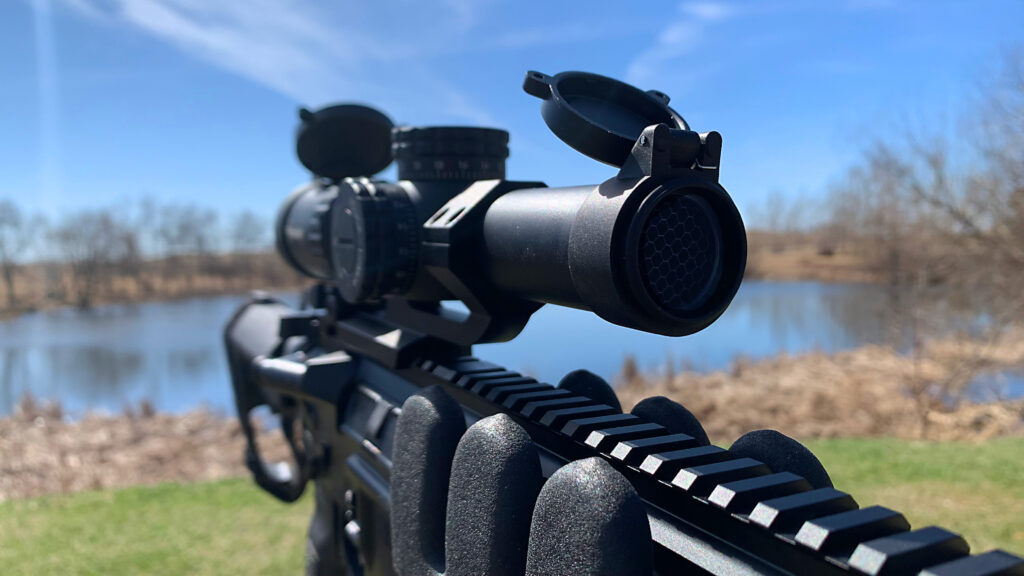
The mount…
The Firefield Rapidstrike 1-10×24 CR1 ships with a mount, so you’re ready to go right out of the box. Of course, you can use any 30mm scope mount, but let’s face it, most of the mounts I own cost significantly more than this entire setup.
I was careful to use the provided torque specs as you never know when materials or screws may be less robust at this budget, but the mount, which feels relatively lightweight, secured to the Picatinny rail of my Springfield Armament Saint Victor 11.5” AR-15 Pistol (review coming soon) without issue. Does this feel like a bomb-proof ADM, Spuhr, or Badger Ordinance Condition One mount?
Far from it, but it completes the package and gets you to the range without needing to make additional purchases.
Comparisons…
I’ll be honest. I don’t really have that much of a basis for comparison here. By circumstance or fading memory, I can not recall ever testing out a scope in this price range.
For that reason, I’ll compare it to what I know, leaving you to do your part in understanding that I’m not purposely trying to contrast the Rapidstrike 1-10×24 CR1 against optics more than double its price and up for any other reason than to provide a clear picture of what to expect.
Second focal plane, reticle, and zero…
The Firefield Rapidstrike 1-10×24 CR1 is a second-focal plane LPVO. If you’re unaware of the differences between first and second-focal plane optics, in a nutshell, a first-focal plane reticle zooms in with the image when you increase magnification, while a second-focal plane reticle remains the same while only the image zooms in. This means that sub-tensions will only be accurate at a given magnification on a second focal plane optic, typically the highest setting, which, in this case, is ten power.
Having a second focal plane reticle with a magnification range like this works out well. While the advantage of a first focal plane is that your sub-tensions are accurate throughout the magnification range, I find this useful for long-range optics where you are less likely to use maximum magnification for most shots. LPVOs, on the other hand, tend to be used at 1x and cranked to their maximum when magnification is necessary. Second focal plane optics also utilize finer stadia lines at higher magnification for more precise aiming when zoomed in, while also being less expensive to manufacture.
On an LPVO, where the focus is on short to medium-range targets, I tend to use the point-blank range zero method, which skips out on using the Bullet Drop Compensator (BDC) built into the Rapidstrike 1-10 but is also a more straightforward method of setting up an AR-15 you mean to shoot 400 yards and in. I’ll explain.
If I’m looking for practical combat accuracy within an 8-inch circle of my bullseye, my zeroing range for 55gr 5.56x45mm NATO ammunition running approximately 2700FPS out of this 11.5” barrel is right around 36 yards when taking into account the optic’s height over bore. What this setup allows me to do is be within 4 inches up or down from my point of aim out to almost 300 yards using nothing more than my optic’s center aiming point with the understanding that I will be just over 3 inches high at 100 yards and will hit my second point of zero at approximately 250 yards in the bullet’s trajectory. With 0 – 300 yards being that simple, anything beyond that is a matter of finding a 400-yard target and recording where in the BDC reticle corresponds to hits at that distance.
It’s also important to note that the Rapidstrike 1-10×24 CR1 features tactical elevation and windage turrets, which we will talk more about later, but these get you to practice generating ballistic charts using velocity and load data which will allow you to dial in your shot for longer or more precision applications. Just make sure you’re set to 10x magnification when you do this.
If you would rather use the BDC reticle provided with the Firefield Rapidstrike 1-10×24 CR1, the setup method is straightforward for that also, using a 100-yard zero with drop compensation hashes doubling as shoulder-to-shoulder ranging estimations out to 600 yards.

Zeroing is the optic, no matter which method you choose, is simple. Find the center of a decent 3-shot group, make your adjustments on the turrets, confirm your zero, and then reset the turrets. Use the provided tool to unscrew the center cap on each turret, gently lift the turret off the scope completely, rotate it so the zero lines up with the markings on the scope, then set it back in place screwing the center caps back down to secure the turrets. You’re done.

| TECHNICAL SPECIFICATIONS | |
| Reticle type | CR1 |
| Reticle | Etched |
| Reticle color | Black / Red / Green |
| Illuminated (yes/no) | Yes |
| Reticle brightness settings | 0-5 |
| Magnification (x) | 1-10 |
| Objective lens diameter (mm) | 24 |
| Eyepiece diameter (in/mm) | 1.81 / 46 |
| Exit pupil diameter (in/mm) | 0.39 – 0.12 / 10.0 – 3.0 |
| Eye relief (in/mm) | 3.94 / 100 |
| Field of view (ft @100yd) | 119.2 – 12.05 |
| Field of view (m @100m) | 39.7 – 4.0 |
| Diopter adjustment (+/-) | -2/+2 |
| Tube diameter (mm/in) | 1.18in / 30mm |
| Parallax setting (yds) | 100 |
| Adjustment (one click =) | 1/2 MOA |
| Windage adjustment range (MOA) | 100 |
| Elevation adjustment range ({MOA) | 100 |
| Windage & Elevation lock (yes/no) | Yes |
| Maximum caliber | 0.338 |
| Battery type | CR2032 |
| Battery life (hours) | Low: 260 Mid: 80 High: 20 |
| Battery voltage (V) | 3 |
| Sunshade (yes/no) | No |
| Nitrogen filled (yes/no) | Yes |
| Shockproof (yes/no) | Yes |
| Fog proof (yes/no) | Yes |
| Focal plane | Second |
| IP Standard (water rating) | IPX5 – water resistant |
| Body material | Aluminum |
| Finish/color | Matte black |
| Lens coatings | Fully multi-coated |
| Operating temperature (°F/°C) | -13 to 131 / -25 to 55 |
| Length (in/mm) | 10.71 / 272 |
| Width (in/mm) | 2.60 / 66.0 |
| Height (in/mm) | 2.24 / 57.0 |
| Weight without mount (oz / g) | 17.6 |
| Weight with mount (oz / g) | 22.6 |
Turrets…
Turrets on the Rapidstrike 1-10×24 CR1 adjust in half MOA increments, which is not as precise as optics providing quarter MOA adjustments, but it will get the job done. Both the elevation and windage turrets lock to keep your settings from shifting with accidental bumps. To unlock and adjust, pull them outwards and dial. Simply push the turrets back in to lock those settings.
To my surprise, the turrets on this Firefield LPVO are quite tactile, providing audible clicks and a positive feel while dialing, something I didn’t expect to this extent on such an inexpensive scope. Using my darkroom method of dialing random settings and then back to zero strictly by feeling and hearing each click of the turret worked very well.
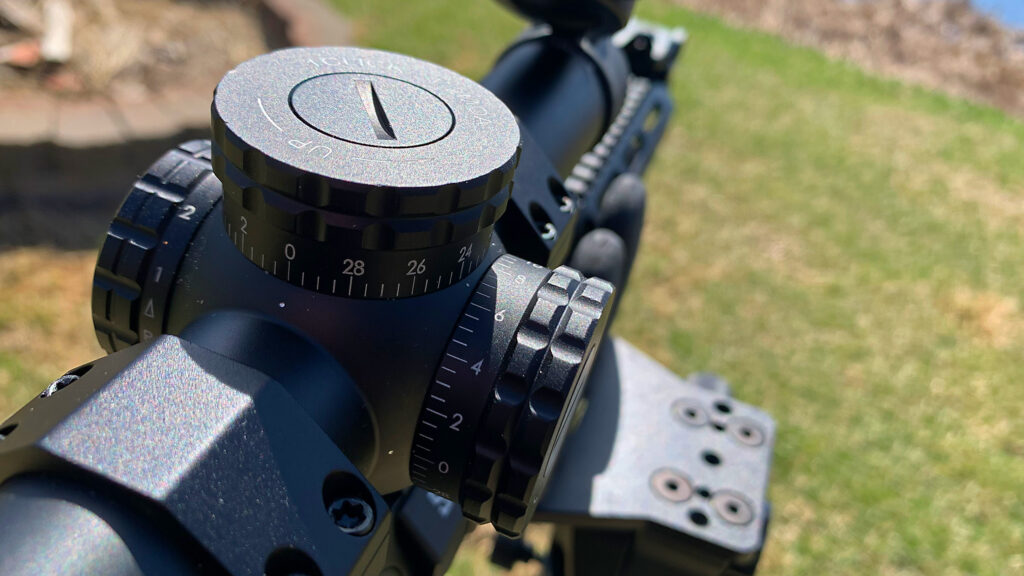
Illumination
The Firefield Rapidstrike 1-10×24 CR1 has an interesting feature regarding its illumination settings. From the off position, the knob can be turned in either direction, giving the user five brightness settings of either red or green illumination depending on which direction you dial.
Having multiple color options in one LPVO reticle is new to me, and while it isn’t a monumental step forward in usability, an optic in this price range works well for someone trying to figure out what they like and don’t like without breaking the bank, and multicolor illumination supports that learning curve.
Don’t expect the illumination in either color to be red dot bright, but with that being said, I did find it bright enough under all but the harshest lighting conditions.
When the daylight is at its brightest, the illumination color gets a little washed out like many LPVOs, however, the remaining black horseshoe reticle is clearly visible with plenty of contrast to make shots under these conditions without hesitation.
On the rifle
I didn’t abuse the Rapidstrike 1-10 with any more purpose than my normal routine, throwing my rifle into the truck and heading out to my shooting spots on the ranch, carrying it slung, and of course shooting. Keeping with the range gun and learning theme, I stuck to the basics, using .223 55gr FMJ provided by HOP Munitions, which runs without a hiccup like all of the company’s ammunition I’ve tested, including their excellent 147gr 9mm poly flat nose.
I did notice the magnification ring was a little stiff at first and is definitely not the hot knife through butter like you’ll find on a Vortex Razor or comparable optic, but it did smooth out a little bit over time, and the throw lever makes the experience that much less of an issue.
Firefield lists eye relief at just shy of 4 inches, and to be honest, I had zero issues in this department and found the eyebox adequately forgiving as well. After shooting approximately 300 rounds, I did not notice any shift in zero or mechanical issues. Things just seemed to work.
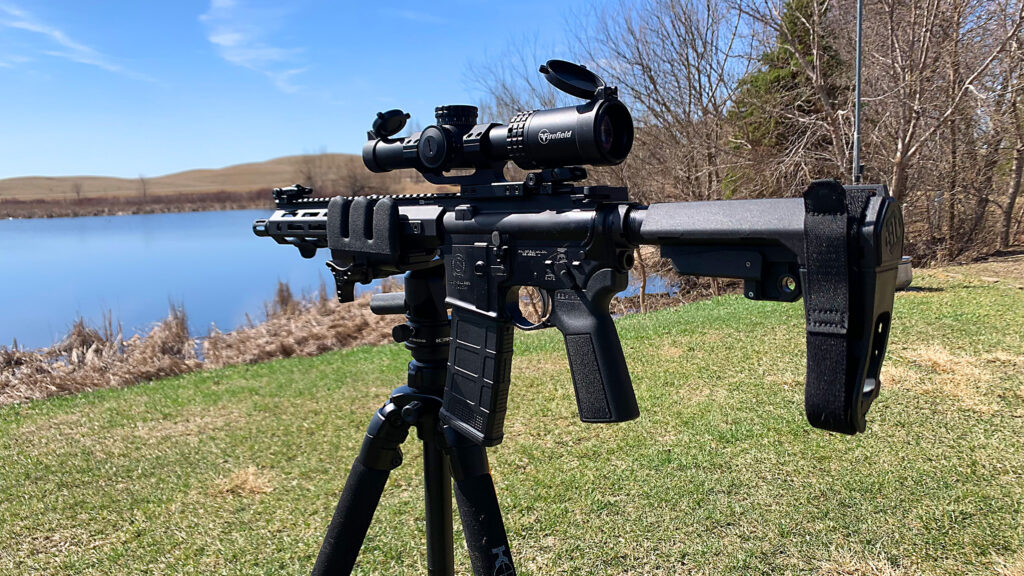
Optical Quality
Here is where we make some sacrifices relative to higher-end optics, but not necessarily to overall usability. The image at 1x is plenty bright for an LPVO with a 30mm tube and 24mm objective lens, and surprisingly that brightness does not suffer much throughout the zoom range, at least not to the extent that I noticed. 1x is adequately flat as well, with more distortion and clarity falloff towards the edges than something like the Griffin 1-10, but being isolated far enough from the center of the image circle that it wasn’t something I noticed during practical use.
In fact, the only sacrifice I am spoiled enough to have noticed throughout this review is the limited field of view through the magnification range. Of course, I was not only comparing it to the Griffin 1-10 at more than double the price but also a Vortex Razor Gen III 1-10 which has an MSRP right around $4000. Both of those optics also have the advantage of 34mm main tubes. To be somewhat fair, I compared the field of view to my Primary Arms PLXc 1-8 which also runs a 30mm tube and the PLXc seemed to provide a noticeably wider field of view as well.

The majority of the Rapidstrike 1-10 image circle is relatively clear, giving me zero issues identifying targets out to 400 yards and beyond at 10x. This isn’t the crystal clear view you’d expect from higher-end glass like the Razor and the PLXc, and the Griffin Armament 1-10 sets itself apart here also with a perceptible increase in optical clarity and color fidelity. The Rapidstrike did display a bit more chromatic aberration as well under moderate lighting conditions, with noticeable but non-distracting purplish magenta color fringes behind objects with brightly contrasted backgrounds.
That being said, I did not suffer any terrible eye fatigue when spending longer periods behind the optic as I would have thought, making overall usability beyond what I would have bet on for a $200 setup going into this review.
Conclusion
I think the most important aspect of reviewing an optic like this is identifying who might benefit from it. In the case of the Rapidstrike 1-10 CR1, I think it is an optic that can provide some insight to shooters who are starting out and don’t know if they prefer an LPVO, a red dot with magnifier, or a prism setup without having to risk a lot of money to find out.
I also know plenty of guys out there with more rifles than they know what to do with, but not all of them are serious use applications, and some of them aren’t equipped with an optic or even a set of iron sights. In those cases, a functional entry-level setup is better than a rifle without any sort of aiming device.

Optics have come a long way over the years, both on the high end and in the budget-friendly variety. If I were just starting and wanted to exercise my right to train with a rifle without spending copious amounts of cash, I’d be much more likely to spend money on ammunition and range time. Once you have a more solid foundation for what you like and don’t like, there will be plenty of time to upgrade down the road, and hopefully, the experience you’ve gained will guide you to purchase products more suitable to your needs and shooting style as the price tags become increasingly painful, and they will.
I would not compare the Firefireld Rapidstrike 1-10 CR1 to the Griffin Armament 1-10x Mil-R SFP as an alternative, despite these two being the most budget-friendly 1-10x LPVOs I currently have access to. The Griffin is built like a tank and outperforms the Rapidstrike across the board, but like anything, that comes at a price. In this case, it happens to be two and a half times the price, plus you’ll need to buy a mount, likely leaving you with a purchase at least three times the cost of this entire setup. Instead, the Rapidstrike 1-10 focuses on economy and is more of an entry-level option that will do everything you need well enough to give you a strong start down the path and a functional firearm to train with.
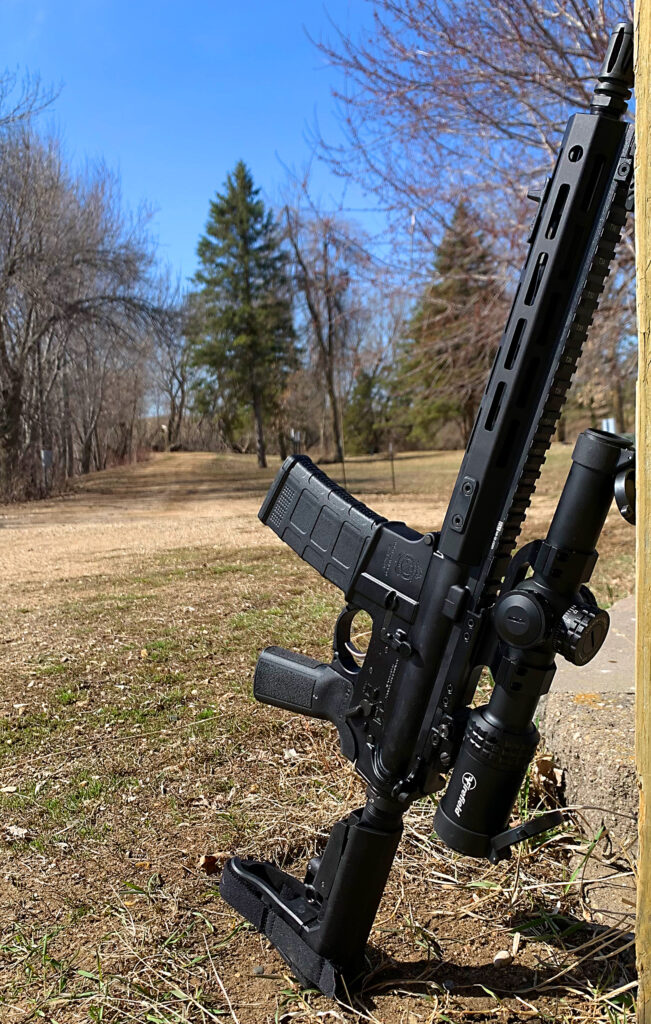
For more information on Firefield’s entire line of optics, lasers, and accessories, please visit firefield.com.
Where To Buy

Read the full article here







